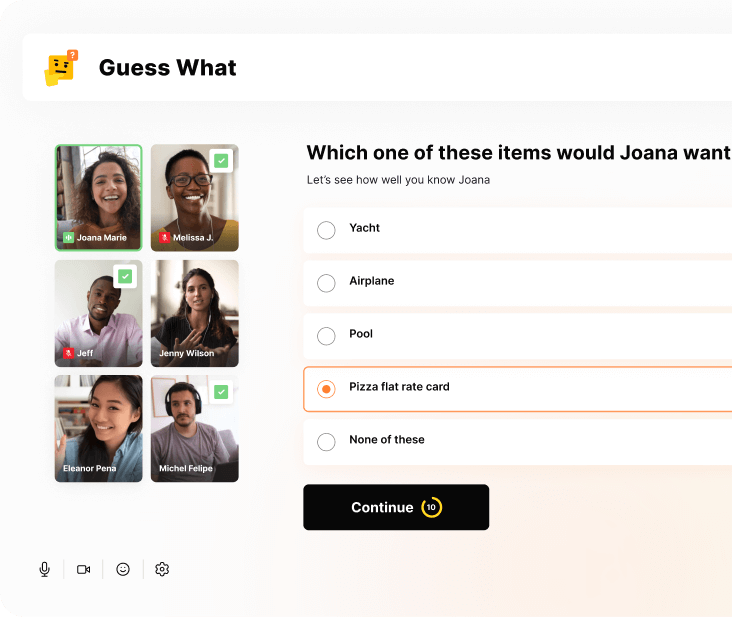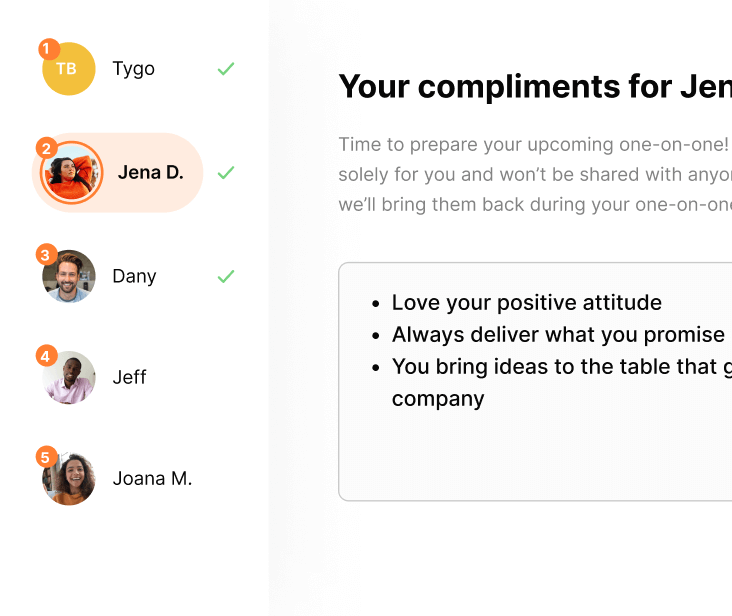Back to Blog
Why recognition at work skyrockets employee engagement
Whether it’s in marriage, friendships, or at work: Feeling valued is one of the foundations for strong relationships.
That includes the relationship between employees and their managers. The science is clear on the matter. When employees don’t feel recognized, their likelihood to leave is 74% higher, and they’re five times more likely to be actively disengaged (translation: they hate work).
It’s also common sense. When you work your butt off and nobody recognizes your efforts, you’ll look for a place that does.
To understand the impact of recognition on engagement more closely, we gathered the latest research.
Recognition at work has a major impact on employee engagement
There are countless ways recognition improves work. Thus far, research has proven two (plus one extra):
- When employees don’t feel recognized, they leave.
- Employees who feel recognized are more engaged.
- (There are also studies that show a connection between employee engagement and performance. So you could also suggest that employees who feel recognized likely do better work)
1. Poor recognition leads to disengagement and a 74% higher likelihood of losing an employee
A survey conducted by Gallup and Workhuman in 2022 illustrates what happens when employees don’t feel recognized.
The study found that employees who receive little recognition (a few times a year or less) are
- five times more likely to be disengaged (= slow working tempo, lack of interest in work, easily and prolongingly distracted, and minimal output” Pech & Slade, 2006),
- 74% more likely to consider leaving the organization,
- and 27% more likely to be struggling.
Workhuman, selling a recognition solution, has a vested interest in making the impact of recognition seem as high as possible. So we have to take these numbers with a grain of salt.
2. Employees who feel recognized are 4x more engaged and half as likely to look for another job
On the flip side, employees who feel recognized are reportedly
- four times more likely to be engaged,
- less than half as likely to consider leaving,
- and 44% more likely to be thriving.
Gallup and Workhuman also offer models to put a price tag on recognition (“what’s the ROI of recognition culture?”).
Hot take: If you need a price tag to convince yourself or leadership that recognition of employees is important, you can probably skip the rest of this article 😉.
How often and in what ways should you give recognition? (+examples)
The first question to ask yourself is, “Are we recognizing each other often enough?”. Some research to guide your thinking:
- 52.5% of employees want to be recognized more often (source).
- Most employees want to be recognized at least weekly or monthly by their manager (source).
- Surprisingly, employees expect more frequent recognition from their peers than their manager (source).
Takeaway: Recognizing your team members once a week seems to be the safe bet. Make sure you have systems in place for peer recognition.
There are countless ways to give recognition. To some degree, it depends on the preferences of the employee, your leadership style, company culture, etc.
Here’s what research says about the best ways to recognize employees:
- “A new growth opportunity is the most valued type of recognition. Other forms of recognition—salary increases, high-performance ratings and bonuses—were far less popular, selected by 23%, 21% and 10%, respectively.
- 40% of professionals prefer recognition for success over knowledge or expertise, effort and living core values.
- Showing appreciation doesn’t need to be shared widely to count. Most people prefer recognition shared with just a few people or delivered privately.
- Three quarters of people are satisfied receiving a "thank you" for their everyday efforts, as opposed to a gift or celebration.”
From Forbes: Knowing How Your Employees Want To Be Recognized (And For What) Is Key To Their Engagement
Share fun facts and bond with a team quiz
Have your participants choose from a list of questions they’d like their coworkers to answer about them, before watching as they guess the right answer.
01. Yes
share-fun-facts-and-bond-with-a-team-quiz

Run a guided recognition activity
Have your participants choose from a list of questions they’d like their coworkers to answer about them, before watching as they guess the right answer.
01. Yes
run-a-guided-recognition-activity

Organize a virtual cooking class
Hire a professional chef to help your team cook a delicious lunch or dinner. May be difficult for co-workers with families. To find providers and get tips, read our blog about virtual cooking classes.
02. No
organize-a-virtual-cooking-class

Hire a stand-up comedian
Have your participants choose from a list of questions they’d like their coworkers to answer about them, before watching as they guess the right answer.
02. No
hire-a-stand-up-comedian

No items found
No items found
Table of contents
Whether it’s in marriage, friendships, or at work: Feeling valued is one of the foundations for strong relationships.
That includes the relationship between employees and their managers. The science is clear on the matter. When employees don’t feel recognized, their likelihood to leave is 74% higher, and they’re five times more likely to be actively disengaged (translation: they hate work).
It’s also common sense. When you work your butt off and nobody recognizes your efforts, you’ll look for a place that does.
To understand the impact of recognition on engagement more closely, we gathered the latest research.
Recognition at work has a major impact on employee engagement
There are countless ways recognition improves work. Thus far, research has proven two (plus one extra):
- When employees don’t feel recognized, they leave.
- Employees who feel recognized are more engaged.
- (There are also studies that show a connection between employee engagement and performance. So you could also suggest that employees who feel recognized likely do better work)
1. Poor recognition leads to disengagement and a 74% higher likelihood of losing an employee
A survey conducted by Gallup and Workhuman in 2022 illustrates what happens when employees don’t feel recognized.
The study found that employees who receive little recognition (a few times a year or less) are
- five times more likely to be disengaged (= slow working tempo, lack of interest in work, easily and prolongingly distracted, and minimal output” Pech & Slade, 2006),
- 74% more likely to consider leaving the organization,
- and 27% more likely to be struggling.
Workhuman, selling a recognition solution, has a vested interest in making the impact of recognition seem as high as possible. So we have to take these numbers with a grain of salt.
2. Employees who feel recognized are 4x more engaged and half as likely to look for another job
On the flip side, employees who feel recognized are reportedly
- four times more likely to be engaged,
- less than half as likely to consider leaving,
- and 44% more likely to be thriving.
Gallup and Workhuman also offer models to put a price tag on recognition (“what’s the ROI of recognition culture?”).
Hot take: If you need a price tag to convince yourself or leadership that recognition of employees is important, you can probably skip the rest of this article 😉.
How often and in what ways should you give recognition? (+examples)
The first question to ask yourself is, “Are we recognizing each other often enough?”. Some research to guide your thinking:
- 52.5% of employees want to be recognized more often (source).
- Most employees want to be recognized at least weekly or monthly by their manager (source).
- Surprisingly, employees expect more frequent recognition from their peers than their manager (source).
Takeaway: Recognizing your team members once a week seems to be the safe bet. Make sure you have systems in place for peer recognition.
There are countless ways to give recognition. To some degree, it depends on the preferences of the employee, your leadership style, company culture, etc.
Here’s what research says about the best ways to recognize employees:
- “A new growth opportunity is the most valued type of recognition. Other forms of recognition—salary increases, high-performance ratings and bonuses—were far less popular, selected by 23%, 21% and 10%, respectively.
- 40% of professionals prefer recognition for success over knowledge or expertise, effort and living core values.
- Showing appreciation doesn’t need to be shared widely to count. Most people prefer recognition shared with just a few people or delivered privately.
- Three quarters of people are satisfied receiving a "thank you" for their everyday efforts, as opposed to a gift or celebration.”
From Forbes: Knowing How Your Employees Want To Be Recognized (And For What) Is Key To Their Engagement
Setting up employee recognition and engagement programs
The most common recognition programs companies offer are
- Health and wellness
- Learning and development
- Celebrating life events (kiddos, birthdays, retirement, etc.)
- Employee of the month programs
While those are definitely great starting points, they’re also a bit rigid. Consider adding the following approaches to your recognition program.
1. Create systems that support recognition
Systems are ways to make recognition unavoidable and impossible for your company to forget. Steer clear of forcing people to recognize each other. Instead, make it easy for them and give gentle nudges.
Here are a few ideas for recognition systems:
- Managers have a bi-weekly calendar reminder to recognize a team member
- Use Slack/Microsoft Teams tools (see below) to send out automatic reminders
- Every month, invite your team to an Appreciation Shower session
- Make recognition a part of quarterly performance reviews, e.g., by providing a performance review template to managers
- The company sets up “Appreciation Fridays”, a day where everyone starts late and shares who they appreciate
2. Use employee recognition software to automate nudges and incentives
Almost three years after the onset of Covid, there are plenty of affordable tools that help with recognition. Here are some of our favorites:
- Gomada: Run an Appreciation Shower session to boost recognition and get Slack reminders to appreciate each other. Starts free.
- Kudos: A recognition platform starting at $5 per user per month.
- Bonusly: A bit like Kudos, except with rewards and incentives. From $3 per month per user (annual plans only).
- Nectar: An HR tool for building culture, including recognition features.
Keep on reading: Further research on employee recognition
If you’d rather paint yourself a picture of how recognition and engagement are connected, we’ve listed the four most noteworthy resources we’ve come across in our research below:
- Workhuman & Gallup: Unleashing the Human Element at Work: Transforming Workplaces Through Recognition
- BambooHR & Quantum Workplace: Recognition in the Workplace
- SHRM: Using Recognition and Other Workplace Efforts to Engage Employees
- Forbes: Knowing How Your Employees Want To Be Recognized (And For What) Is Key To Their Engagement
Subscribe to get our latest updates
Subscribe to get our latest updates




.jpg)

